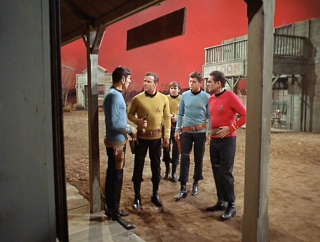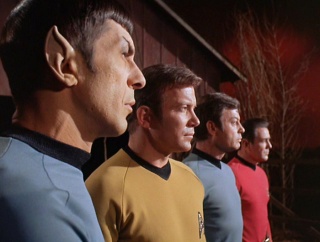I recently watched a Star Trek: The Next Generation (TNG) episode called The Bonding, which was penned by Battlestar Galactica (2004 series) creator Ronald D. Moore. "The Bonding" was Moore's spec script he wrote in 1988. The history behind the script is that Moore was on tour of the Paramount studio where they filmed Star Trek. Moore showed the script to the show's creator Gene Roddenbery's assistant, who liked it and was able to get Moore an agent.
"The Bonding" eventually made its way to Michael Piller (who had been promoted to lead writer of the third season). Piller purchased the script and the episode aired during the show's third season on October 23, 1989. I believe that Moore's introduction into Star Trek not only helped the show's transformation, but is an example of fandom writing that finds its way into prime time TV. Moreover, "The Bonding" is an early example of what is now commonly referred to as the re-imagining of a previous TV show or movie.
Before Piller was promoted to lead writer, the original ST and the first two seasons of TNG were primarily "alien of the week" situations. Though many of the "alien of the week" scenarios were great episodes, TNG, arguably, had no clear identity. During the third season, however, the themes of the episodes gradually turned inward, developing deeper characterization to reflect the inner-selves of the crew of the Enterprise. During the third season would begin to form TNG's identity. "The Bonding" would play an important role in the series transformation.
The episode centers on the story of a young boy named Jeremy Aster, who's mother (Lt. Marsah Aster) is unexpectedly killed on a scientific mission. Worf, who was apart of the mission, is upset about Marsha's death because it reminds him of the passing of his own parents. Jeremy and Worf come together through a Klingon ritual called the R'uustai - a bonding where the two become brothers.
One can think of textual poaching as readers who rent spaces, but never fixed in one location. But whereas de Certau sees poaching as a tacit and lone process of appropriation, Jenkins extends the concept of textual poaching into the world of fandom, where fans' expression is outwardly projected such as attending conferences or sharing information on the web.

The story of "The Bonding" retains the integrity and history of the Star Trek series as well as re-imagining new ideas within that world. That is, Moore expands and renews the traits and identities of characters already established by previous ST writers while giving them more depth and complexity. For example, Moore creates a character arc for Worf by introducing the backstory of Worf''s father's honor who had been rejected by the Klingon's. A story that would further develop in the 4th and 5th season. Moreover, "The Bonding" contains themes that Moore would fully explore in Battlestar Galatica such as honor, loyalty and solidarity.













